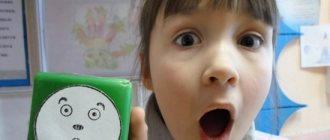Features of articulation of the posterior lingual and types of disorders
When pronouncing K, the lips take the form of the subsequent vowel or half-smile, the teeth are open. The tip of the tongue is located at the bottom, and itself is shaped like a slide. The back of the backrest should touch the back of the roof of your mouth.
The lateral edges of the tongue should be pressed against the upper lateral teeth. When you say K, the vocal cords are not working, they are not closed. The exhalation must be strong in order to open the closure that forms between the back of the tongue and the palate.
The incorrect pronunciation of this sound is called cappacism, and its replacement with another is called paracappacism. There are several types of these violations:
- Instead of K, a guttural click is obtained. It is formed as a result of the fact that the vocal cords close, and during breathing there is additional pressure on them. When the child says K, the air comes out with a noise, which adds a guttural click.
- In speech there is a replacement with T.
- Replaces with X.
If there are any of these disturbances in speech, it is necessary to conduct a diagnosis and correct the sound pronunciation.
Reasons for violations
Children usually learn to pronounce correctly through onomatopoeia. But if there are deviations in the structure and operation of the articulatory apparatus, then the pronunciation of a certain sound group (or several) will be impaired. In the case of cappacism, this is an irregular shape of the hard palate, which causes difficulty in forming the bow necessary for correct articulation.
In addition, the cause may be weak or increased muscle tone of the tongue. Then the tongue cannot occupy or hold the desired position, which also affects pronunciation. The reason for the appearance of paracappacisms is the insufficient formation of phonetic-phonemic processes.
These types of sound pronunciation disorders may be signs of the following speech disorders:
- dyslalia - simple and complex forms;
- dysarthria;
- rhinolalia;
- alalia.
If there is a complex speech disorder, then it is necessary to provide comprehensive assistance, which includes not only sessions with a speech therapist, but also with a speech pathologist, and a consultation with a neurologist.
Causes of sound pronunciation problems
If the baby pronounces a number of sounds incorrectly and indistinctly, then it is worth being examined by a neurologist and speech therapist. The causes of problems with sound pronunciation may be different. However, it is necessary to identify the problem in a timely manner in order to select an effective correction program.
Dyslalia can occur due to:
- pathologies of the development of the speech apparatus (malocclusion, short frenulum, etc.);
- presence of two languages in the family;
- incorrect approach to the development of a child’s speech (communication in a “lisping” language);
- hearing loss;
- problems with sound pronunciation in one of the parents (children tend to tremble).
Dysarthria develops with damage to the central nervous system, which can be caused by:
- problems during intrauterine development;
- injuries during childbirth (umbilical cord entanglement, etc.);
- cerebral palsy;
- Rhesus conflict;
- serious infections that the child suffers;
- problems with blood circulation in the brain;
- brain injuries.
Even serious problems with the pronunciation of sounds can be corrected. However, many parents have one question. If sound pronunciation can be corrected, then why do many adults speak incorrectly? This is due to two factors. Some parents believe that there is nothing wrong with the incorrect pronunciation of certain sounds. There are also cases when they begin to provide assistance without identifying the cause of the speech defect. Naturally, correction of dyslalia with dysarthria will not have an effect.
Diagnostics of sound pronunciation
The speech therapist evaluates sound pronunciation, looks at the state of the articulatory apparatus and phonemic processes. First, the specialist studies the anatomical structure of the articulation organs, then evaluates their work. To do this, the speech therapist asks to perform exercises to maintain a certain position, gives tasks for motor skills (raise and lower the tongue, show the horse, etc.).
Then the specialist asks the child to say the desired sound. First, he pronounces it without combination with other sounds, in syllables with vowels and other consonants. Then in words, phrases, sentences, coherent speech. In tasks for assessing coherent speech, you need to compose a story based on a picture, talk about your favorite toy or cartoon, or on any other topic.
The purpose of tasks for phonetic-phonemic perception is whether the child distinguishes K in the speech stream and does not confuse it with sounds similar in acoustic characteristics. The speech therapist pronounces different sounds, the child needs to select the one he needs. Then the material is complicated - they pronounce it in words, syllables. An adult can ask you to name all the objects that contain K. A good task is to distribute the pictures into groups for a specific sound.
The specialist pays attention to the speech environment in which the child grows up. If one of the adults around him has kappacism or parakappacism, then either he also needs to correct his pronunciation, or try to use fewer words with the sound K when communicating with the baby.
Norms for the development of sound pronunciation
If a child has difficulty pronouncing sounds, this is not always a cause for concern. In some cases, this is an age-related developmental norm. At each stage of growing up, a child acquires certain speech skills.
- from 1 month – children begin to unconsciously pronounce the vowel sounds “Y”, “U”, “A”, “E”. In infancy, the child mostly lies down, and the tongue can be thrown back. Therefore, sometimes the baby manages to pronounce several back-lingual sounds, for example, “G” or “X”;
- from 4 to 5 months - children try to practice reproducing individual sounds;
- from 5 to 10 months – the baby moves from individual sounds to syllables. Usually these are "Ba", "Ta", "Pa", Da" and "Ma". The number of syllables gradually increases. If up to 4 months the baby “booms,” then from 5 to 10 months he “babbles”;
- from 10 to 18 months - the child tries to pronounce his first words. By this point, children are able to consciously reproduce most of the vowel sounds - “A”, “Y”, “O”, “E”, “I” and “U”, as well as some consonant letters - “M”, “T”, “ P", "D", "B", "N", "K", "V", "G", "Y", "F", "X";
- from 1.5 to 3 years - the child is able to pronounce several whistling sounds - “C”, “S” and “Z”. If he cannot cope with this task, then you should pay attention to the situation. Note that from 1.5 to 2 years the baby often pronounces sounds incorrectly. For example, instead of “З” it is used “Дь” (“tooth”/“doubt”/“oak”). By the age of three, children often experience a softening of vowel and consonant sounds (“tumba - “tyumbya”, “baby - “crumpled”). As a rule, this goes away by the age of four;
- from 3 to 4 years. Children proceed to play hissing sounds - “Shch”, “Sh”, “Ch” and “Zh”. Until this moment, as a rule, they replace them with similar ones - “Sh” with “S” (“school” - “skola”), “Ch” with “C” or “T” (“chub” - “tsyub” / “tube”), etc. If a child up to five years old does not pronounce hissing sounds well, then this is the norm. The baby gradually learns, so these letters may not be pronounced correctly in all words. There is a partial replacement of sounds, for example, “the cat caught the mouse,” etc. It is important to regularly work with the child and correct him. Then he will quickly master the new sound;
- from 4 to 5 years. The appearance of sonorous sounds is observed. But up to 4.5 years, for example, the hard “L” can be replaced with the soft “L”. By the age of five, the child can already pronounce “R” and “L” well. This is the most complex group of sounds. Therefore, there is no need to demand from a child that at the age of three he clearly says “fish”, “crayfish” and other “growling” words. Moreover, if you put a lot of pressure on your baby, he may begin to pronounce “R” in the manner of the French language. This deviation will be more difficult to correct at an older age. Remember that it is better to turn on the sound when it is not there yet than to re-teach the child.
Naturally, all children are individual. Therefore, minor deviations from the norm are allowed. If parents constantly talk and practice with their child, then such a child pronounces sounds correctly by the age of five. However, more and more often preschool children have problems with sound pronunciation. Please note that if a child pronounces sounds incorrectly while at school, he may have problems learning to read and write.
Staging methods
The easiest way to stage it at home is by onomatopoeia. To do this, ask your child to cough (cough). You should open your mouth wide so that your baby can see the correct articulation. You need to cough with a small exhalation so that there is no pronounced X between K and E.
Then offer to cough in a whisper. This will help remove the X sound, the result should be the syllable KE. Practice this syllable, then invite your child to combine it with other vowels. Try speaking the sound in isolation.
But the onomatopoeic method does not always help in cases of complex speech disorders. For such options, there are other ways to set the back-lingual group of sounds:
- Staging while inhaling. The adult asks to hide the tongue as far as possible. Be sure to show your child how to do this. With this inhalation, you need to pronounce syllables like KA. After practicing, make the task more difficult: inhale like this, and say this syllable as you exhale. When the back-lingual sound becomes clear, practice its pronunciation in isolation.
- Mechanical method. For this you need a speech therapy spatula. Ask your baby to pronounce the syllables TA-TA-TA. You press the tip of your tongue with the spatula and gently push it deep into your mouth. Before doing this, be sure to warn your child about what you will do and ask him not to remove his tongue. When you hear a clear K, focus your baby’s attention on its sound. Let the child try to pronounce it without the help of an adult. Of course, he may not be able to immediately pronounce it on his own, and an adult will need to help him. When the child learns to say it on his own, begin to consolidate it in syllables.
These were ways to make the K sound yourself at home. Most often, it can be delivered using onomatopoeia, because the articulation of the back-linguals has the same base. And if a child has one of the sounds of this group, then he will quite easily learn the articulation of other back-lingual sounds.
Parents ask a speech therapist: “The child cannot pronounce the letter K, how can he quickly learn correct articulation?” First, the speech therapist sets up sounds and letters are taught in literacy classes. Secondly, the duration of correctional work depends on the speech disorder and the individual characteristics of the child.
How to teach a child to say the letter “K”?
If you decide to study with your child at home, then parents should master the methods of pronouncing the sound “k”, make a selection of special speech therapy games and exercises that will help teach him to pronounce this letter.
Before conducting classes teaching your child correct literary pronunciation (spelling), you should perform several general speech therapy exercises to warm up the speech apparatus. The most effective are:
- "Tube". The child should extend his lips forward with a tube and hold in this position for 5 seconds.
- "Smile". The baby should be asked to smile as wide as possible, but not show his teeth.
- "Snake". The child should be asked to stick his tongue out and in between tightly compressed lips 5 to 7 times.
- "Fence". The son or daughter should smile, showing the lower and upper teeth.
- “Brushing our teeth.” The child opens his mouth as wide as possible and runs his tongue along the inside of the upper teeth, then the lower ones, first from left to right, and then vice versa.
Articulation gymnastics is carried out for 10 minutes. With its help, you can prepare the speaking muscles of the face to perform games and exercises aimed at mastering the sound “k”.
Methods for making the sound “k”
The sound “k” belongs to the group of back-lingual sounds. To pronounce it, you need a high rise at the root of the tongue. Children often skip these sounds or replace them with easier-to-pronounce front-lingual ones. If we exclude pathologies due to which the baby cannot pronounce the letter “k,” then we can say that the child’s tongue is lazy to work at full capacity.
If the child is unable to speak the letter “k”, the child replaces it with the letter “t” (“tofta” instead of “jacket”, “tapitan” instead of “captain”, “Tatya” instead of “Katya”, etc.). In some situations, it is enough for parents to clearly pronounce the sound a couple of times so that the child sees their facial expressions and can repeat it. But not all children immediately grasp the correct pronunciation.
One of the methods for teaching how to pronounce the letter “k” is a mechanical technique. The parent invites the son or daughter to pronounce the syllables “ta-ta-ta” several times. While he does this, mom or dad presses the tip of the tongue down and moves it slightly back. You can perform the manipulation using your finger or the handle of a teaspoon.
The tongue moves back, presses against the palate, and gradually takes the position necessary for a clear pronunciation of the sound “k”. It is enough to repeat the technique several times, then the baby begins to pronounce the letter without outside help.
Consolidating the sound “k” in a child’s speech
After the baby learns to pronounce the letter “k” on his own, parents should pronounce with him every day as many words as possible in which it is used. Tongue twisters (“The pussy has soft paws”, “We bought a cuckoo hood”, “Dwarf Karl was tumbling on the carpet”, “Klava put a bow on the shelf”, etc.), proverbs or poems are also suitable for this purpose.
Games and exercises
To teach your child to pronounce the letter “k”, you should do the following exercises with him:
- "Slide downhill." The child is taught to hold his tongue in a slide position. Then a cotton ball is placed on his palm. Next, the baby should keep the root of the tongue slightly raised, while lowering its tip. After completing the steps described above, the child should exhale air, blowing the ball off his palm. When performing this exercise, the sound “k” should be heard. Not all children are able to pronounce it the first time.
- "The language is a fighter." One of the parents and son or daughter sit in front of the mirror. The child should be told that his tongue turns into a fighter who will have to fight with an enemy (mom or dad's index finger). The baby begins to smile with his mouth open as wide as possible, and at this time the adult rests his finger on the tip of his tongue, pushing it back a little. The child tries to push the finger out of the mouth. The parent finger then moves to the front wall of the tongue, pressing lightly on it. Eventually, the baby's tongue will take the "slide" position necessary for the correct pronunciation of the "k" sound. Next, the child will be able to put his tongue in the correct position without struggling with the adult’s finger. When performing this exercise, parents should be extremely careful not to scratch the baby's mouth with their nails or cause a gag reflex. Hands must be washed clean.
5 recommendations for parents
Conducting speech classes gives results, but in addition to them, parents should play games with their baby that promote the development of fine motor skills.
Why do you need to develop fine motor skills and what are the benefits of it? This article will tell you.
Mom or dad can sort through cereals or pasta with him, teach the child to string beads on a thread or fishing line, and sculpt figures from plasticine or salt dough.
- Speech therapists and speech pathologists also recommend that parents:
- Ask the baby to repeat the sound if he pronounced it successfully.
- When a child has learned to say a letter, its pronunciation is reinforced by pronouncing phrases, syllables and words with it.
- Mom or dad can invite the child to remember words with the sound “k” on his own, name pictures from a book where it is present.
- A child should not be forced to study if he does not want to or does not feel well.
- If there is no result from studying at home, the child is shown to a speech therapist or defectologist.
Recommendations for parents on automation and differentiation
Once you have established the correct pronunciation, you need to reinforce it in your speech. You need to start working on automation with something simple - with syllables, gradually complicating the speech material to compiling stories and retellings. If, in addition to cappacism, the child has paracappacism, then when choosing words for reinforcement, be careful: the words should not contain sounds that are similar in acoustic characteristics.
The child says T instead of K - this is one of the most common forms of paracapacism. In general, replacing one sound with another may be due to the absence of one of them. At the differentiation stage, be sure to talk through the articulation of mixed sounds with your child and focus on their differences.
To differentiate, start with isolated pronunciation. When the child can accurately identify the desired sound, complicate the speech material. But the mixed sounds must be in a strong position so that the child can hear them clearly. This stage needs to be worked out only when the child’s sound pronunciation is corrected and the stage of automation in syllables and words is underway, then the correction work will be effective.









